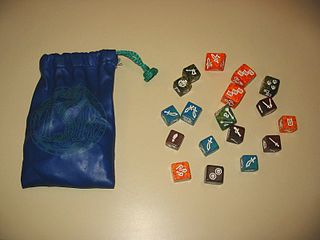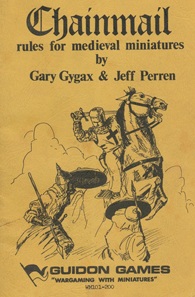Related Research Articles

A wargame is a strategy game in which two or more players command opposing armed forces in a simulation of an armed conflict. Wargaming may be played for recreation, to train military officers in the art of strategic thinking, or to study the nature of potential conflicts. Many wargames re-create specific historic battles, and can cover either whole wars, or any campaigns, battles, or lower-level engagements within them. Many simulate land combat, but there are wargames for naval, air combat, and cyber as well as many that combine various domains.

Warhammer 40,000 is a miniature wargame produced by Games Workshop. It is the most popular miniature wargame in the world, and is particularly popular in the United Kingdom. The first edition of the rulebook was published in September 1987, and the tenth and current edition was released in June 2023.
Confrontation is a skirmish level tactical fantasy miniature wargaming in which the combatants are represented by metal or plastic figures in 28 mm scale. For comparison purposes, the system's figures are slightly larger than those of Games Workshop or The Foundry.

Dominions II: The Ascension Wars is a 4X turn-based, computer strategy game. It was developed by Illwinter Game Design and published by Shrapnel Games. The game was released on November 14, 2003 in North America for Microsoft Windows, Mac OS X and Linux.
De Bellis Antiquitatis or DBA is a fast play set of rules for the hobby of historical miniature wargaming, particularly ancient and medieval wargaming in the period 3000 BC to 1520 AD. Now in 3rd edition. These rules allow entire armies to be represented by fewer than 50 figures. The rules also include diagrams and over 600 army lists. DBA is produced by the Wargames Research Group and was the first game in the DBx series, which now includes De Bellis Multitudinis (DBM), De Bellis Magistrorum Militum, Hordes of the Things, De Bellis Renationis. and for 1700-1920 Horse Foot and Guns (HFG) An online video game titled DBA OnlineArchived 2006-11-11 at the Wayback Machine was also created.

Warhammer is a tabletop miniature wargame with a medieval fantasy theme. The game was created by Bryan Ansell, Richard Halliwell, and Rick Priestley, and first published by the Games Workshop company in 1983.

Warmaster is a ruleset for tabletop wargames written by Rick Priestley, published by Specialist Games, and set in the Warhammer Fantasy setting. It is different from Warhammer Fantasy Battles in both appearance and gameplay. It is intended for 10 –12 mm miniatures. Basic troops are based on stands, of which typically three make a unit. Generals, Heroes and Wizards are mounted individually or with their retinue.

Fantasy Warlord is a fantasy miniatures game released in 1990 by Folio Works. It was written by Ian Bailey and Gary Chalk who also did the illustrations.

Dragon Dice is a collectible dice game originally made by TSR, Inc., and is produced today by SFR, Inc. It is one of only a handful of collectible dice games produced in the early 1990s. The races and monsters in Dragon Dice were created by Lester Smith and include some creatures unique to a fantasy setting and others familiar to the Dungeons & Dragons role-playing game.

Greyhawk Wars is a fantasy board wargame that was published by TSR, Inc. in 1991. The game was designed by David Cook as a strategic simulation of the eponymous Greyhawk Wars on the fictional world of Oerth, the World of Greyhawk campaign setting for the Dungeons & Dragons role-playing game.

Chainmail is a medieval miniature wargame created by Gary Gygax and Jeff Perren. Gygax developed the core medieval system of the game by expanding on rules authored by his fellow Lake Geneva Tactical Studies Association (LGTSA) member Jeff Perren, a hobby-shop owner with whom he had become friendly. Guidon Games released the first edition of Chainmail in 1971.

Battlesystem is a tabletop miniature wargame designed as a supplement for use with the Dungeons & Dragons role-playing game. The original Battlesystem was printed as a boxed set in 1985 for use with the first edition AD&D rules. For the second edition of AD&D, a new version of Battesystem was printed as a softcover book in 1989.
Real-time tactics (RTT) is a subgenre of tactical wargames played in real-time, simulating the considerations and circumstances of operational warfare and military tactics. It is differentiated from real-time strategy gameplay by the lack of classic resource micromanagement and base or unit building, as well as the greater importance of individual units and a focus on complex battlefield tactics.

Hordes is the name of a 30mm tabletop miniature wargame produced by Privateer Press, announced at Gen Con 2005 and released on April 22, 2006. Although a completely standalone game in its own right, Hordes was designed as a companion to Warmachine, Privateer Press' flagship miniatures game. The games are 100% compatible, and share much of the same rules set, although the most important mechanic - fury for Hordes and focus for Warmachine - remains unique to each. Hordes forces and Warmachine forces often face off against each other both on the tabletop and in the background fiction. The games share the same setting, the Iron Kingdoms, with much of the Hordes storyline taking place in the wild areas away from the 'civilized' areas where Warmachine's major action takes place.
De Bellis Multitudinis (DBM) is a ruleset for table-top miniatures wargames for the period 3000 BC to 1485 AD. It is the big battle development of De Bellis Antiquitatis. As its name implies, it is aimed primarily at simulating large battles. The rules allow armies to be chosen from published Army Lists using a points system to select roughly equal armies if required.

Dominions 3: The Awakening is a fantasy turn-based strategy game created by Illwinter and published in 2006 by Shrapnel Games. It is the third game in the Dominions series, preceded by Dominions: Priests, Prophets and Pretenders and Dominions II: The Ascension Wars. Illwinter's publishing contract with Shrapnel Games expired in November 2012 and Dominions 3 was republished on Desura in late December 2012 and soon after on GamersGate. Dominions 3 went through the Greenlight process and was released on Steam in September 2013.
BattleLore is a strategy board wargame for two players, created by Richard Borg and initially published by Days of Wonder in 2006. The game is based on the same mechanics as Battle Cry, Memoir '44 and Commands & Colors: Ancients, but has a fantasy and medieval theme.
Demonworld is a tabletop wargame originally created by Hobby Products, a German gaming company. The game went out of production for several years but has recently been purchased and re-released by Ral Partha Europe, as announced on 8 June 2011.

Chronicles of Osgorth: The Shattered Alliance is a 1981 computer wargame published by Strategic Simulations in January 1982 for the Apple II and Atari 8-bit computers. Programmed by John Lyon, it relies on a new game engine, called RapidFire, intended to make faster and easier access to wargames published by the studio. During a turn, the program selects the units each in turn and the player only has to order them to move, attack or cast a spell. The order is then executed immediately before the program selects another unit. The game offers two categories of scenarios. The first is composed of medieval-fantasy confrontation, including a free adaptation of the Battle of Gondor against the Mordor forces in the Lord of the Rings. The second is composed of historical battles of antiquity.

Fantasy Warriors is a fantasy miniatures board game for two players that was published by Grenadier Models Inc. in 1990.